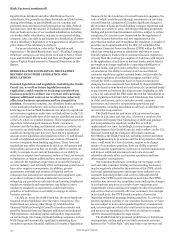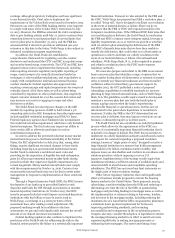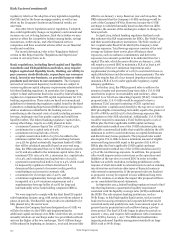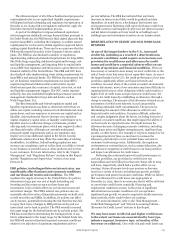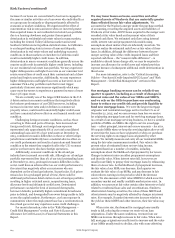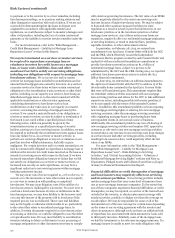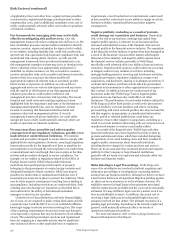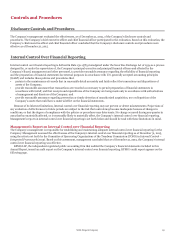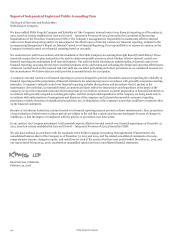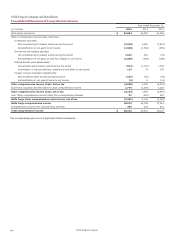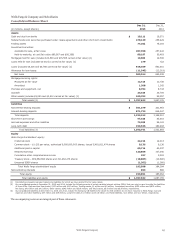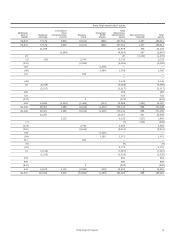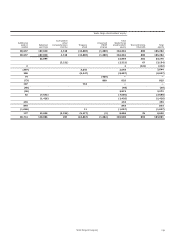Wells Fargo 2015 Annual Report Download - page 132
Download and view the complete annual report
Please find page 132 of the 2015 Wells Fargo annual report below. You can navigate through the pages in the report by either clicking on the pages listed below, or by using the keyword search tool below to find specific information within the annual report.Risk Factors (continued)
and other assets and liabilities may have no direct observable
price levels, making their valuation particularly subjective, being
based on significant estimation and judgment. In addition,
sudden illiquidity in markets or declines in prices of certain
loans and securities may make it more difficult to value certain
balance sheet items, which may lead to the possibility that such
valuations will be subject to further change or adjustment and
could lead to declines in our earnings.
The Sarbanes-Oxley Act of 2002 (Sarbanes-Oxley) requires
our management to evaluate the Company’s disclosure controls
and procedures and its internal control over financial reporting
and requires our auditors to issue a report on our internal
control over financial reporting. We are required to disclose, in
our annual report on Form 10-K, the existence of any “material
weaknesses” in our internal controls. We cannot assure that we
will not identify one or more material weaknesses as of the end
of any given quarter or year, nor can we predict the effect on our
stock price of disclosure of a material weakness. Sarbanes-Oxley
also limits the types of non-audit services our outside auditors
may provide to us in order to preserve their independence from
us. If our auditors were found not to be “independent” of us
under SEC rules, we could be required to engage new auditors
and re-file financial statements and audit reports with the SEC.
We could be out of compliance with SEC rules until new
financial statements and audit reports were filed, limiting our
ability to raise capital and resulting in other adverse
consequences.
RISKS RELATED TO ACQUISITIONS
Acquisitions could reduce our stock price upon
announcement and reduce our earnings if we overpay
or have difficulty integrating them. We regularly explore
opportunities to acquire companies or businesses in the financial
services industry. We cannot predict the frequency, size or
timing of our acquisitions, and we typically do not comment
publicly on a possible acquisition until we have signed a
definitive agreement. When we do announce an acquisition, our
stock price may fall depending on the size of the acquisition, the
type of business to be acquired, the purchase price, and the
potential dilution to existing stockholders or our earnings per
share if we issue common stock in connection with the
acquisition.
We generally must receive federal regulatory approvals
before we can acquire a bank, bank holding company or certain
other financial services businesses depending on the size of the
financial services business to be acquired. In deciding whether to
approve a proposed acquisition, federal bank regulators will
consider, among other factors, the effect of the acquisition on
competition and the risk to the stability of the U.S. banking or
financial system, our financial condition and future prospects
including current and projected capital ratios and levels, the
competence, experience, and integrity of management and
record of compliance with laws and regulations, the convenience
and needs of the communities to be served, including our record
of compliance under the Community Reinvestment Act, and our
effectiveness in combating money laundering. As a result of the
Dodd-Frank Act and concerns regarding the large size of
financial institutions such as Wells Fargo, the regulatory process
for approving acquisitions has become more complex and
regulatory approvals may be more difficult to obtain. We cannot
be certain when or if, or on what terms and conditions, any
required regulatory approvals will be granted. We might be
required to sell banks, branches and/or business units or assets
or issue additional equity as a condition to receiving regulatory
approval for an acquisition. In addition, federal law prohibits
regulatory approval of any transaction that would create an
institution holding more than 10% of total U.S. insured deposits,
or of any transaction (whether or not subject to prior approval)
that would create a financial company with more than 10% of the
liabilities of all financial companies in the U.S. As of
September 30, 2015, we believe we already held more than 10%
of total U.S. deposits. As a result, our size may limit our bank
acquisition opportunities in the future.
Difficulty in integrating an acquired company or business
may cause us not to realize expected revenue increases, cost
savings, increases in geographic or product presence, and other
projected benefits from the acquisition. The integration could
result in higher than expected deposit attrition, loss of key team
members, disruption of our business or the acquired business, or
otherwise harm our ability to retain customers and team
members or achieve the anticipated benefits of the acquisition.
Time and resources spent on integration may also impair our
ability to grow our existing businesses. Also, the negative effect
of any divestitures required by regulatory authorities in
acquisitions or business combinations may be greater than
expected. Many of the foregoing risks may be increased if the
acquired company or business operates internationally or in a
geographic location where we do not already have significant
business operations and/or team members.
* * *
Any factor described in this Report or in any of our other SEC
filings could by itself, or together with other factors, adversely
affect our financial results and condition. Refer to our quarterly
reports on Form 10-Q filed with the SEC in 2016 for material
changes to the above discussion of risk factors. There are factors
not discussed above or elsewhere in this Report that could
adversely affect our financial results and condition.
Wells Fargo & Company
130


